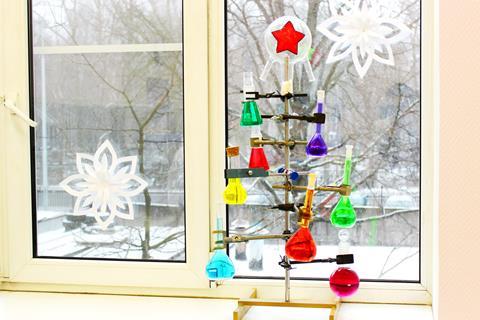Nothing says Christmas to a chemistry teacher more than a lesson dedicated to creating a chemistree
Every year scientists and science teachers around the world celebrate Pi day (14 March and designated International day of mathematics by UNESCO) and Mole day (23 October between 6.02am and 6.02pm). These celebrations, mostly informal and often quirky, bring scientific communities together on a regional and international basis. But chemists have another annual tradition: the chemistry Christmas tree or chemistree.
Germany is credited with starting the tradition of Christmas trees in the 16th century. It is widely believed that Protestant reformer, Martin Luther first added lit candles to a tree. However devout puritans like Oliver Cromwell were strongly opposed to Christmas trees and, in fact, until the 1840s they were largely seen as pagan symbols. It was only really with the influx of German and Irish immigrants to the US and UK from the mid 19th century that Christmas trees became accepted into religious celebrations.

From small acorns
But how did we get from Christmas trees to chemistrees? One of the earliest reports is from 1940. At a US high school students made a tree from ‘ring stands, rings, burette clamps and rubber tubing’ under the direction of their teacher. In 1956, another report described the chemical Christmas tree as a useful way to teach indicators and the nomenclature of equipment. So it seems the chemistree has its origins firmly planted in the school laboratory as a fun teaching aid. Personally, I feel the Chemistree encourages a sense of community through a shared activity, and that’s particularly true for schools. It sets chemistry and other science students apart, giving them something exclusive to their community.
These shared, group experiences and the sense of connectedness they bring are an important part of social development in adolescents, reducing feelings of isolation and contributing to a sense of belonging. Evidence suggests that ordinary experiences shared by a group of people are amplified and retain significant longevity over an exciting experience witnessed individually. The effect is further enhanced when those in the group are familiar with one another, like classmates. School classes naturally form social bonds, so light-hearted group activities like building a chemistree can encourage collegiality and a sense of community.
These shared, group experiences and the sense of connectedness they bring are an important part of social development in adolescents, reducing feelings of isolation and contributing to a sense of belonging. Evidence gathered in 2020 (bit.ly/3TKfHdU) suggests that ordinary experiences shared by a group of people are amplified and retain significant longevity over an exciting experience witnessed individually. The effect is further enhanced when those in the group are familiar with one another, like classmates. School classes naturally form social bonds so light-hearted group activities like building a chemistree can encourage collegiality and a sense of community.
Evergreen or deciduous?
Contrary to popular belief, evergreen trees do lose their leaves but only gradually and not all at once like deciduous trees. Evergreens can therefore survive in environments that just don’t work for their deciduous cousins. For example, heavy loads of snow can break the branches of deciduous trees, as their broad leaves catch a lot of snow. The drooping conifer needles on evergreens catch far less snow. This may explain why evergreen conifers dominate mountaintops and the boreal forests that stretch across high latitudes in North America and Europe – just another factor contributing to the popularity of the Christmas tree in these regions.
Growing a community
About 15 years ago I started the O chemistree competition. It all started as a distraction from the real work of finishing my PhD when I began judging chemistrees for fun on social media. Although the expansion of social media over the past decade has led to numerous debates about their positive and negative aspects, there is no doubt in my mind that social media has also contributed to greater connections between people with similar interests – and the growth of the O chemistree competition. With more and more teachers now using social networks to share ideas and resources, community activities like building a chemistree can help participants establish their identity as a chemistry educator. I love seeing teachers use social networks to freely share ideas and resources because it demonstrates the supportive nature of teaching. This is also why the O chemistree competition is so important to me, because it invites participation from everyone and helps cultivate a sense of community in chemistry classrooms all over the world.
Get involved
The 2022 competition opens on 7 December and the theme is biological and organic chemistry, in honour of this year’s chemistry Nobel prize winners. I’ll also be setting up a survey – I really want to know what you think about the competition so do please take part. And keep an eye on the Twitter hashtag #OChemistree.














No comments yet